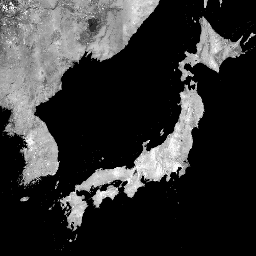
- Disponibilidade de conjuntos de dados
- 2007-01-01T00:00:00Z–2020-01-01T00:00:00Z
- Provedor de conjunto de dados
- JAXA EORC
- Tags
Descrição
Uma versão mais recente desse conjunto de dados com dados de 2015 a 2021 pode ser encontrada em JAXA/ALOS/PALSAR/YEARLY/SAR_EPOCH
O mosaico global de 25 m do PALSAR/PALSAR-2 é uma imagem global de SAR contínua criada pela junção de faixas de imagens de SAR do PALSAR/PALSAR-2. Para cada ano e local, os dados de faixa foram selecionados por inspeção visual dos mosaicos de navegação disponíveis durante o período, sendo usados preferencialmente aqueles que mostram resposta mínima à umidade da superfície. Em casos em que a disponibilidade era limitada (por exemplo, devido à necessidade de observações durante emergências específicas), os dados foram selecionados do ano anterior ou posterior, incluindo 2006. Shimada et al. 2014
Não há dados de 2011 a 2014 devido à diferença entre a cobertura temporal do ALOS e do ALOS-2.
As imagens de SAR foram ortorretificadas e corrigidas por inclinação usando o modelo digital de elevação SRTM de 90 m. Um processo de remoção de faixas (Shimada & Isoguchi, 2002, 2010) foi aplicado para igualar as diferenças de intensidade entre faixas vizinhas, que ocorrem principalmente devido a diferenças sazonais e diárias nas condições de umidade da superfície.
Os dados de polarização são armazenados como números digitais de 16 bits (DN). Os valores de DN podem ser convertidos em valores de gama zero em decibel (dB) usando a seguinte equação:
- γ₀ = 10log₁₀(DN²) - 83,0 dB
Atenção:
- Os valores de retroespalhamento podem variar significativamente de um caminho para outro em áreas florestais de alta latitude. Isso ocorre devido à mudança na intensidade de retroespalhamento causada pelo congelamento das árvores no inverno.
Saiba mais na Descrição do conjunto de dados do provedor.
Bandas
Tamanho do pixel
25 metros
Bandas
| Nome | Unidades | Tamanho do pixel | Descrição |
|---|---|---|---|
HH |
metros | Coeficiente de retroespalhamento de polarização HH, DN de 16 bits. |
|
HV |
metros | Coeficiente de retroespalhamento de polarização HV, DN de 16 bits. |
|
angle |
graus | metros | Ângulo de incidência local. |
date |
metros | Data da observação (dias desde 1º de janeiro de 1970). |
|
qa |
metros | Processando informações. |
Tabela de classes de qa
| Valor | Cor | Descrição |
|---|---|---|
| 0 | #000000 | Não há dados |
| 50 | #0000ff | Oceano e água |
| 100 | #aaaa00 | Escala de radar |
| 150 | #005555 | Sombreamento de radar |
| 255 | #aa9988 | Terra |
Termos de Uso
Termos de Uso
A JAXA mantém a propriedade do conjunto de dados e não garante nenhum problema causado ou possivelmente causado pelo uso dos conjuntos de dados. Qualquer pessoa que queira publicar resultados usando os conjuntos de dados precisa reconhecer claramente a propriedade dos dados na publicação.
Citações
Masanobu Shimada, Takuya Itoh, Takeshi Motooka, Manabu Watanabe, Shiraishi Tomohiro, Rajesh Thapa e Richard Lucas, "New Global Forest/Non-forest Maps from ALOS PALSAR Data (2007-2010)", Remote Sensing of Environment, 155, pp. 13-31, dezembro de 2014. doi:10.1016/j.rse.2014.04.014.
Explorar com o Earth Engine
Editor de código (JavaScript)
var dataset = ee.ImageCollection('JAXA/ALOS/PALSAR/YEARLY/SAR') .filter(ee.Filter.date('2017-01-01', '2018-01-01')); var sarHh = dataset.select('HH'); var sarHhVis = { min: 0.0, max: 10000.0, }; Map.setCenter(136.85, 37.37, 4); Map.addLayer(sarHh, sarHhVis, 'SAR HH');
